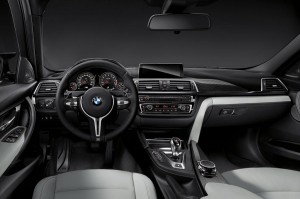We test the newly updated BMW 3 Series in 340i Sport guise. Has BMW moved the game on again?
All engines are now turbocharged – from the new three-cylinder 318i and trusted 320d right through to this range-topping six-cylinder 340i – the only engine available to drive on the international launch. There’s a new 320i, too, and the 328i has been rebadged as a 330i to reflect a jump in power. While the 320d and super-frugal 320d EfficientDynamics will offer most things to most people – this 340i should help us decipher if the 3 Series is still the best-handling car in its class.
Only available in the UK in top-spec M Sport specification, our test car was actually in lesser Sport trim – with smaller wheels and less dynamic styling. However, options such as the brilliant adaptive dampers, as well as the sweet-shifting eight-speed auto gearbox were both fitted.
The 340i gets a sweet sounding 321bhp turbocharged six-cylinder engine, and replaces the previous flagship 335i. It gets an extra 19bhp and another 50Nm of torque – though for manual models 0-62mph takes an identical 5.5 seconds. The automatic is slightly faster (0-62mph in 5.1 seconds) and feels suitably eager in-gear. Despite not using a dual-clutch setup it can shift cogs remarkably fast, too. So fast in fact, that the gearbox feels quite snatchy in Sport and Sport+ mode.
Leave it in Comfort though, and the 3 Series remains fast, refined and of course, comfortable. The ride is just the right side of firm, and body control is excellent. Like before, the 3 Series is great fun to drive, changing direction like nothing in its class and inspiring confidence from behind the wheel.
We didn’t drive a car without the adaptive dampers, but from previous experience we’d suggest whichever model you go for – be it a 320d or 340i – adjustable suspension is a must.
Elsewhere, BMW says tweaks to the steering have improved feel – but we’re not convinced. In fact, due to feedback from China and the U.S. (the 3 Series’ biggest market) engineers have actually introduced a really small flat spot when the car is driving dead ahead. This allows an ever-so-slight amount of play on the wheel before anything kicks in – to avoid unintentional sharp changes of direction at high speed. Apparently the old one was too twitchy. However, it only affects a degree or two off centre, and once you’re on a flowing country road you’d be hard pushed to tell the difference.
While driver enjoyment has always been a key selling point for BMW, it also majors on running costs. The 320d EfficientDynamics now emits 99g/km of CO2, and with a light right foot will return 74.3mpg. The numbers are less impressive for this six-cylinder 340i though, and company car buyers will wince at the high 30 per cent Benefit in Kind bracket (26 per cent for this more efficient auto).
That said, this big-engined 3 Series offers Porsche Cayman performance with more than 30mpg combined fuel economy. A like-for-like Jaguar XE S is thirstier and will cost business buyers even more given its 33 per cent BiK rate.
Practicality remains unchanged. That means all cars get the same 480-litre boot and spacious interior – with enough room in the back for three adults at a push. Buyers concerned with outright space should look at the updated Touring model, though those interested in the hatchback GT should note the styling tweaks aren’t due on that until 2016.
The Jaguar XE brought the fight to the 3 Series earlier this year, and by all accounts surpassed the benchmark BMW. There’s a new Audi A4 on the horizon too, and the classy Mercedes C-Class remains a force to be reckoned with. But BMW’s innovative engineers have done a brilliant job of updating their most popular model and it’s better than ever.






















